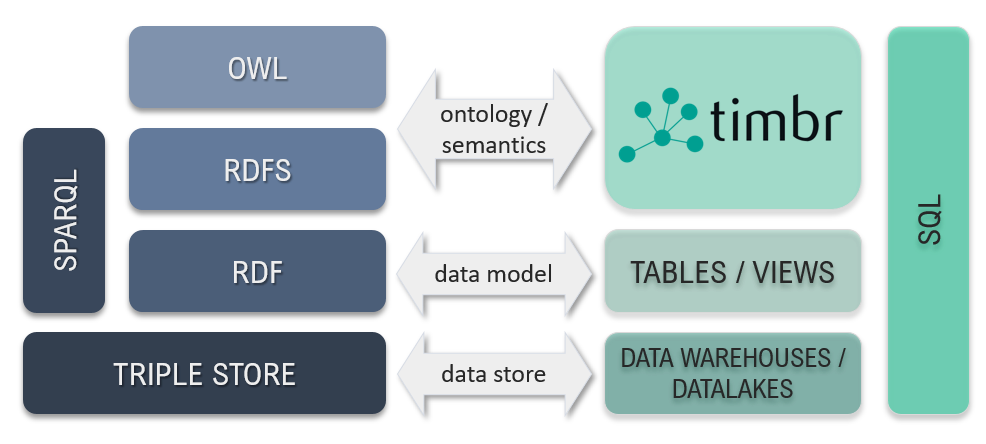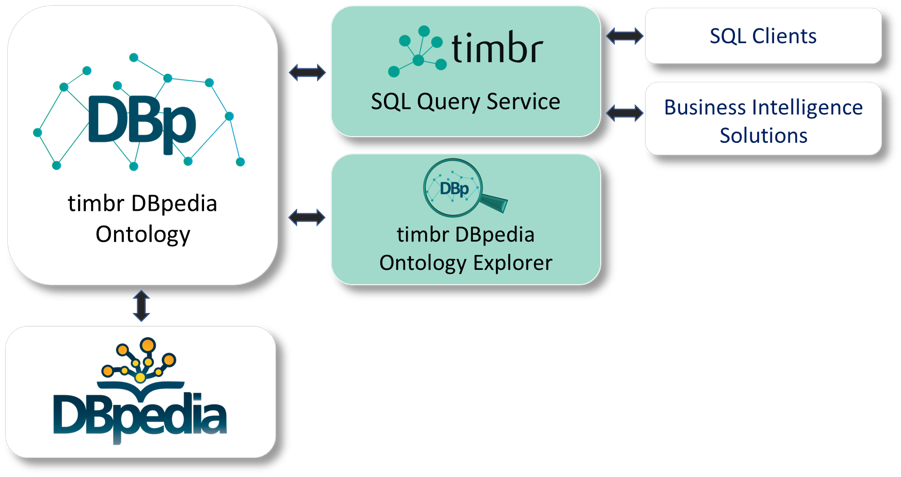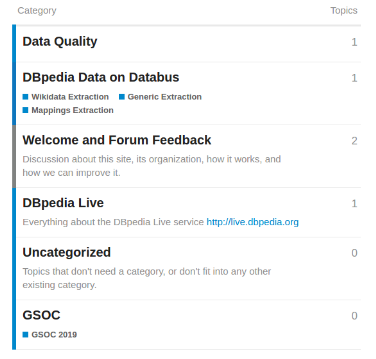The post timbr – the DBpedia SQL Semantic Knowledge Platform appeared first on DBpedia Association.
]]>In part three of DBpedia’s growth hack blog series, we feature timbr, the latest development at DBpedia in collaboration with WPSemantix. Read on to find out how it works.
timbr – DBpedia SQL Semantic Knowledge Platform
Tel Aviv, Israel and Leipzig, Germany – July 18, 2019 – WP-Semantix (WPS) – the “SQL Knowledge Graph Company ” and DBpedia Association – Institut für Angewandte Informatik e.V., announced today the launch of the timbr-DBpedia SQL Semantic Knowledge Platform, a unique version of WPS’ timbr SQL Semantic Knowledge Graph that integrates timbr-DBpedia ontology, timbr’s ontology explorer/visualizer and timbr’s SQL query service, to provide for the first time semantic access to DBpedia knowledge in SQL and to thus facilitate DBpedia knowledge integration into standard data warehouses and data lakes.
” and DBpedia Association – Institut für Angewandte Informatik e.V., announced today the launch of the timbr-DBpedia SQL Semantic Knowledge Platform, a unique version of WPS’ timbr SQL Semantic Knowledge Graph that integrates timbr-DBpedia ontology, timbr’s ontology explorer/visualizer and timbr’s SQL query service, to provide for the first time semantic access to DBpedia knowledge in SQL and to thus facilitate DBpedia knowledge integration into standard data warehouses and data lakes.

DBpedia
DBpedia is the crowd-sourced community effort to extract structured content from the information created in various Wikimedia projects and publish these as files on the Databus and via online databases. This structured information resembles an open knowledge graph which has been available for everyone on the Web for over a decade. Knowledge graphs are a new kind of databases developed to store knowledge in a machine-readable form, organized as connected, relationship-rich data. After the publication of DBpedia (in parallel to Freebase) 12 years ago, knowledge graphs have become very successful and Google uses a similar approach to create the knowledge cards displayed in search results.
Query the world’s knowledge in standard SQL
Amit Weitzner, founder and CEO at WPS commented: “Knowledge graphs use specialized languages, require resource-intensive, dedicated infrastructure and require costly ETL operations. That is, they did until timbr came along. timbr employs SQL – the most widely known database language, to eliminate the technological barriers to entry for using knowledge graphs and to implement Semantic Web principles to provide knowledge graph functionality in SQL. timbr enables modelling of data as connected, context-enriched concepts with inference and graph traversal capabilities while being queryable in standard SQL, to represent knowledge in data warehouses and data lakes. timbr-DBpedia is our first vertical application and we are very excited by the prospects of our cooperation with the DBpedia team to enable the largest user base to query the world’s knowledge in standard SQL.”

Sebastian Hellmann, executive director of the DBpedia Association commented that:
“our vision of the DBpedia Databus – transforming Linked Data into a networked data economy, is becoming a reality thanks to tools such as timbr-DBpedia which take full advantage of our unique data sets and data architecture. We look forward to working with WPS to also enable access to new data sets as they become available .”
timbr will help to explore the power of semantic technologies
Prof. James Hendler, pioneer and a world-leading authority in Semantic Web technologies and WPS’ advisory board member commented “timbr can be a game-changing solution by enabling the semantic inference capabilities needed in many modelling applications to be done in SQL. This approach will enable many users to get the advantages of semantic AI technologies and data integration without the learning curve of many current systems. By giving more people access to the semantic version of Wikipedia, timbr-DBpedia will definitely contribute to allowing the majority of the market to explore the power of semantic technologies.”
timbr-DBpedia is available as a query service or licensed for use as SaaS or on-premises. See the DBpedia website: wiki.dbpedia.org/timbr.
About WPSemantix
WP-Semantix Ltd. (wpsemantix.com) is the developer of the timbr SQL semantic knowledge platform, a dynamic abstraction layer over relational and non-relational data, facilitating declaration and powerful exploration of semantically rich ontologies using a standard SQL query interface. timbr is natively accessible in Apache Spark, Python, R and SQL to empower data scientists to perform complex analytics and generate sophisticated ML algorithms. Its JDBC interface provides seamless integration with the most popular business intelligence solutions to make complex analytics accessible to analysts and domain experts across the organization.
WP-Semantix, timbr, “SQL Knowledge Graph”, “SQL Semantic Knowledge Graph” and associated marks and trademarks are registered trademarks of WP Semantix Ltd.
DBpedia is looking forward to this cooperation. Follow us on Twitter for the latest information and stay tuned for part four of our growth hack series. The next post features the GlobalFactSyncRe. Curious? You have to be a little more patient and wait till Thursday, July 25th.
Yours DBpedia Association
The post timbr – the DBpedia SQL Semantic Knowledge Platform appeared first on DBpedia Association.
]]>The post DBpedia Forum – New Ways to Exchange about DBpedia appeared first on DBpedia Association.
]]>With part II of our growth hack series, we would like to introduce you to the latest feature of our development – the new DBpedia Forum.
Why a new forum?
DBpedia has an inclusionist model and DBpedia is huge. At the core, there is data extracted from Wikipedia and Wikidata. Around this, there are derived datasets like the fusion/enrichment and also LHD. Additionally, we offer services such as DBpedia Spotlight, DBpedia Lookup, SameAs, and not to forget the main endpoint http://dbpedia.org/sparql as well as our DBpedia Chapters. All of this is surrounded by 25k academic papers and a vivid business network.
Since we have this inclusionist model, we believe that access to data and knowledge should be global and unified (and free where possible). That is exactly why we established the DBpedia Forum – to further this mission.
Welcome!
 The DBpedia Forum is a shared community resource — a place to share skills, knowledge, and interests through an ongoing conversation about DBpedia and related topics. It is meant (among others) to replace our old support page for assistance with DBpedia. In the long run, we will shut down our (former) support page, as it is not serving our growing needs anymore.
The DBpedia Forum is a shared community resource — a place to share skills, knowledge, and interests through an ongoing conversation about DBpedia and related topics. It is meant (among others) to replace our old support page for assistance with DBpedia. In the long run, we will shut down our (former) support page, as it is not serving our growing needs anymore.
-
This is what the forum currently looks like. Traffic and communication are still a little low. Start your conversation about DBpedia here and now.
Where are all the DBpedians?
We figured, most of you are already actively involved in exchange about DBpedia. However, the majority of that is scattered all over the web which makes it hard for us and others to keep track of. With the new forum, we offer you a playground for vivid exchange, and to meet and greet fellow DBpedians – a platform for everyone’s benefit.
The DBpedia Forum simplifies communication
Make this a great place for discussion by contributing yourself. It is super easy. Just visit https://forum.dbpedia.org/, browse the topics, and find the info that helps you or add your own. If you want to contribute just register and off you go. Improve the discussion by discovering ones that are already happening. Help us influence the future of the DBpedia community by engaging in discussions that make this forum an interesting place to be.
Transparency is all
To assist with maintaining an appropriate code of conduct the forum utilizes little discourse tools that enable the community to collectively identify the best (and worst) contributions. The forum tracks bookmarks, likes, flags, replies, edits, and many mo re. That is similar to the ranking in the old support system but much more transparent and much more fun.
re. That is similar to the ranking in the old support system but much more transparent and much more fun.
For the hunter-gatherers among you, you can also earn batches for various activities – as long as you are active. And if you feel very passionate about a certain topic, we would gladly make you a moderator – just let us know.
Now is the time
Since you are already talking about DBpedia somewhere on the WWW, why not do it here and now for everyone else to follow? Your knowledge and skills are key, not only for individuals in this forum but also for the whole DBpedia community.
Happy posting and stay tuned for part III in the growth hack series. The next post will feature timbr – DBpedia SQL Semantic Knowledge Platform.
Yours,
DBpedia Association
The post DBpedia Forum – New Ways to Exchange about DBpedia appeared first on DBpedia Association.
]]>The post DBpedia Growth Hack – Fall/Winter 2019 appeared first on DBpedia Association.
]]>A growth hack – how come?
Things have gone a bit quiet around DBpedia. No new releases, no clear direction to go. Did DBpedia stop? Actually not. There were community and board member meetings, discussions, 500 messages per week on dbpedia.slack.com.
We are still there. We, as a community, restructured and now we are done, which means that DBpedia will now work more focused to build on its Technology Leadership role in the Web of Data and thus – with our very own DBpedia Growth Hack – bring new innovation and free fuel to everybody.
What is this growth hack?
We restructured in two areas:
- The agility of knowledge delivery – our release cycle was too slow and too expensive. We were unable to include substantial contributions from DBpedians. Therefore, quality and features stagnated.
- Transparent processes – DBpedia has a crafty community with highly skilled knowledge engineers backing it. At some point, we grew too much and became lumpy, with a big monolithic system that nobody could improve because of side effects. So we designed a massive curation infrastructure where information can be retrieved, adjusted and errors discussed and fixed.
We have been consistently working on this restructuring for two years now and we now have the infrastructure ready as horizontal prototype meaning each part works and everybody can start using it. We ate our own dog food and built the first application.
(Frey et al. DBpedia FlexiFusion – Best of Wikipedia > Wikidata > Your Data (accepted at ISWC 2019) .
Now we will go through each part and polish & document it, and will report about it with a blog post each. Stay tuned !
Is DBpedia Academic or Industrial?
The Semantic Web has a history of being labelled as too academic and a part of it colored DBpedia as well. Here is our personal truth: It is an engineering project and therefore it swings both ways. It is a great academic success with 25,000 papers using the data and enabling research and innovation. The free data drives research on data-driven research. Also, we are probably THE fastest pathway from lab to market as our industry adoption has unprecedented speed. Proof will follow in the blog posts of the Growth Hack series.
Blog Posts of the Growth Hack series:
(not necessarily in that order, depending on how fast we can polish & document )
- Query DBpedia as SQL – a first service on the Databus
- DBpedia Live Extraction – Realtime updates of Wikipedia
- DBpedia Business Models – How to earn money with DBpedia & the Databus
- MARVIN Release Bot – together with https://blogs.tib.eu/wp/tib/ incl. an update of https://wiki.dbpedia.org/Datasets
- The new forum – https://forum.dbpedia.org is already ready to register, but needs some structure. Intended as replacement of support.dbpedia.org
In addition some announcements of on-going projects:
- GlobalFactSync (GFS) – Syncing facts between Wikipedia and Wikidata
- Energy Databus: LOD GEOSS project focusing on energy system data on the bus
- Supply-Chain-Management Databus – PLASS project focusing on SCM data on the bus
So, stay tuned for our upcoming posts and follow our journey.
Yours
DBpedia Association
The post DBpedia Growth Hack – Fall/Winter 2019 appeared first on DBpedia Association.
]]>
